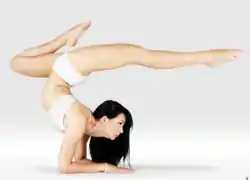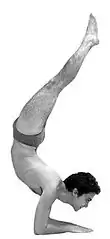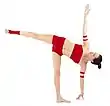Vrischikasana
Vrischikasana or Scorpion pose is an inverted asana in modern yoga as exercise that combines a forearm balance and backbend.[1][2] Light on Yoga treats both forearm and hand balance forms as variants of this pose. It is a part of the headstand cycle in some yoga traditions.[3][4]

A similar pose, Pincha Mayurasana or Feathered Peacock pose, is a forearm balance with the body raised, giving some resemblance to a peacock's tail.
Etymology and origins

The name of this pose is from Sanskrit वृश्चिक vrschika, "scorpion", and आसन āsana, "posture" or "seat".[3] Pincha (Sanskrit पिञ्च Piñcha) means feathered.
The pose is not found in medieval hatha yoga texts, but is described in 20th century manuals such as Light on Yoga.[5]
Description

Because it requires strength, balance, and flexibility it is described as an advanced posture:[3][6] Light on Yoga grades it as level 32 out of 60.[5] In the basic pose, the body is balanced as in headstand, but the legs are bent and the back is lightly arched, and the head is lifted from the ground so the body is supported only by the forearms.[3][4][7] A more advanced variant has the back arched further so the feet touch the top of the head.[3][8] A second advanced variant has the legs held straight out horizontally above the head and arms, resembling the scorpion's tail stretched in a threat posture forwards over its body.[3] The pose can also be executed in a variant with straight arms.[9][10] Whether resting on forearms (Pincha Mayurasana) or with arms in handstand, the asana can be worked towards with the use of a chair to support the feet.[11]
Light on Yoga distinguishes Vrischikasana I (forearm balance, feet on head, plates 536 and 537) and Vrischikasana II (handstand, feet on head, plate 538), describing the second as an "extremely difficult" balance. The placing of the feet on the head is stated to indicate an attempt to subjugate the ego with its "deadly" scorpionlike emotions.[5]
Variations
Pincha Mayurasana (Feathered Peacock Pose), is a forearm balance similar to Vrischikasana, but the legs are straight, stretched up over the head, with the back less extremely arched.[12][13][14]
Sayanasana (Posture of Repose) is the same as Pincha Mayurasana, but with only the elbows on the ground, the hands cradling the face, making it a difficult balance.[14]
Ganda Bherundasana (Formidable Face Pose) is similar to Pincha Mayurasana but with bent arms and only the hands on the ground; the back is lightly arched and the legs and feet point vertically upwards. It may be practised with a block under the shoulders.[15]
See also
References
- "Vrschikasana". Yogapedia. Retrieved 14 November 2018.
- Sherman, Diane. "mastering the scorpion pose - 6 easy steps to vrschikasana". Yogi Times. Retrieved 14 November 2018.
- Lidell, Lucy; The Sivananda Yoga Centre (1983). The book of yoga. London: Ebury. pp. 104-105, 162–163. ISBN 978-0-85223-297-2. OCLC 12457963.
- YJ Editors; Budig, Kathryn (1 October 2012). "Kathryn Budig Challenge Pose: Scorpion in Forearm Balance". Yoga Journal.
- Iyengar, B. K. S. (1991). Light on Yoga. London: Thorsons. pp. 386–388. ISBN 978-0-00-714516-4. OCLC 51315708.
- Pryke, Louise M. (2016). Scorpion. Reaktion Books. pp. 141–142. ISBN 978-1-78023-625-4.
- "Scorpion Pose | Vrschikasana". Vashistha Yoga. Retrieved 14 November 2018.
- "Vrschikasana". iHanuman. Retrieved 14 November 2018.
- Gaia Staff (25 September 2013). "Beginner's Guide to Scorpion Pose". Gaia. Retrieved 14 November 2018.
- Beisecker, Ling (2018). "11 Yoga Poses to Prepare for Scorpion Pose". Do You Yoga. Retrieved 14 November 2018.
- Stennard, Rod (31 July 2018). "Vrschikasana (Scorpion Pose) – Iyengar Yoga". Yoga Selection. Retrieved 14 November 2018.
- "Pincha Mayurasana - AshtangaYoga.info". Retrieved 9 April 2011.
- "Yoga Journal - Feathered Peacock Pose". Retrieved 9 April 2011.
- Iyengar 1979, pp. 285–287.
- Arch, Liz (4 April 2018) [2016]. "Challenge Pose: Ganda Bherundasana (Formidable Face Pose)". Yoga Journal.
Sources
- Iyengar, B. K. S. (1979) [1966]. Light on Yoga: Yoga Dipika. Unwin Paperbacks. ISBN 978-1855381667.
External links
- Yoga poses: Scorpion Pose — Vrschikasana (photographs with basic pose and variants)
_from_Jogapradipika_1830_(detail).jpg.webp)
